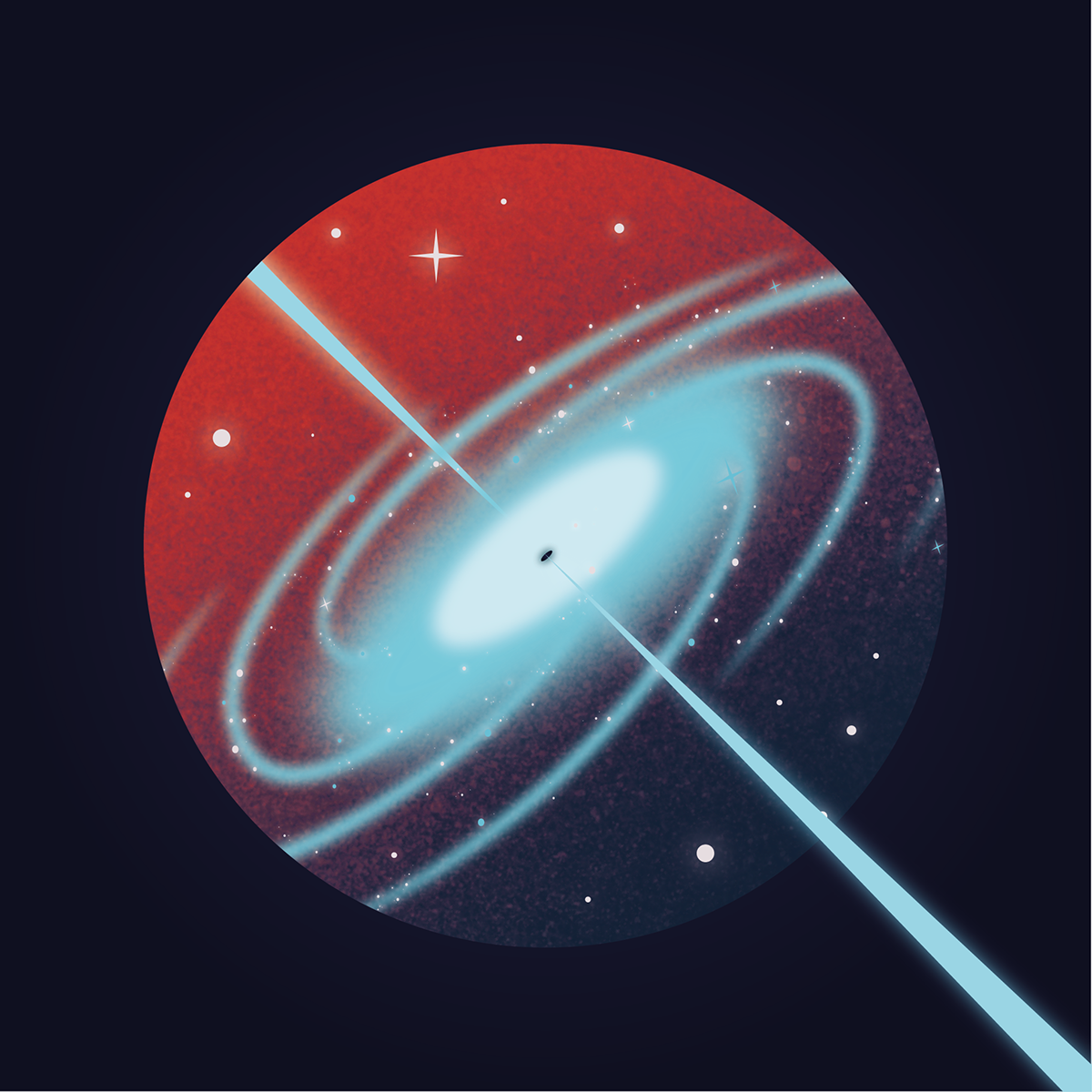
For 36 Days of Type I’ve illustrated letters and numbers based on the topic of ‘Astronomy’, in time for the 50th anniversary of Apollo 11’s moon landing.


A is for Apollo Program
The Apollo program was designed to land humans on the Moon, and to safely bring them back to Earth. The first four flights tested the equipment, six of the other seven flights landed on the moon. The first moon landing took place in 1969, whilst the last was in 1972. Astronaut William Anders took a photo of the earth rising as he orbited the moon during the Apollo 8 mission, it’s considered to be the most influential environmental photograph ever taken.

B is for Black Hole
A black hole is a place in space where gravity pulls so much that even light can not get out. The gravity is so strong because matter has been squeezed into a tiny space, this can happen when a star is dying. They can be of varied size. Using the Event Horizon Telescope In April 2019, astronomers successfully took a photo of a black hole, 55 million LY away in the M87 galaxy.

C is for Crescent Moon
This is a lunar phase describing the moon seen as a crescent when waxing or waning.
It is used as the astrological symbol for the moon, and the alchemical symbol for silver.
It is used as the astrological symbol for the moon, and the alchemical symbol for silver.

D is for Draco
A constellation seen in the far northern sky, it’s Latin name is Dragon. It was one of the 48 constellations listed by the 2nd century astronomer Ptolemy. In Greco-Roman Legend, Draco was a dragon killed by goddess Minerva and upon his defeat, tossed into the sky. It became twisted on itself and froze at the North Celestial Pole before it could right itself.

E is for Equinox
An equinox is when the sun passes directly over the equator, there are two every year. Around the day of the equinox, the length of the day is just over twelve hours, and the night is just under twelve hours. It happens on or near March 21st and September 21st.
Solstices fall on or around June 21st and December 21st.
Solstices fall on or around June 21st and December 21st.

F is for Fireball Meteor
Fireball meteor is another term for a very bright meteor, generally brighter than magnitude -4, which is almost the same magnitude of planet Venus in the morning or evening sky.

G is for Galilean Moons
Galilean Moons are the four largest moons of Jupiter - Io, Europa, Ganymede and Callisto. They were first seen by Galileo Galilei and they were the first objects found to orbit another planet.

H is for Hercules-Corona Borealis Great Wall
The Great GRB Wall is the largest known structure in the observable universe, measuring approximately 10 billion light years in length.
For perspective, the universe is only 13.8 billion years old.

I is for ISS
The International Space Station is a space station in low Earth orbit. It circles the Earth in roughly 92 minutes and completes 15.5 orbits per day.
It has been continuously occupied for over 18 years, and is the largest human-made body in low Earth orbit.
It can be often be seen with the naked eye from Earth.
It has been continuously occupied for over 18 years, and is the largest human-made body in low Earth orbit.
It can be often be seen with the naked eye from Earth.

J is for Juno
Juno is a NASA space probe orbiting the planet Jupiter. It was launched in August 5th, 2011 and entered a polar orbit of Jupiter on July 5th 2016 to begin a scientific investigation of the planet. Once it’s completed it’s mission, Juno will be intentionally de-orbited into Jupiter’s atmosphere.

K is for Kuiper Belt
The Kuiper Belt is a donut-shaped region of icy bodies and leftovers from the Solar System’s early history, that exists beyond the eight major planets.

L is for Lunar Eclipse
A lunar eclipse occurs when the Moon passes directly behind Earth and into its shadow. This can occur only when the Sun, Earth and Moon are exactly or very closely aligned, with Earth between the other two, and can only occur on the night of a full moon.

M is for Milky Way
The Milky Way is a barred spiral galaxy that contains the Solar System. The name describes the galaxy’s appearance from Earth, a hazy band of light in the night sky formed of stars that can’t be individually distinguished by the naked eye. It’s thought there are between 100-400 billions stars within it.

N is for NASA
The National Aeronautics and Space Administration is an independent agency of the United States Federal Government responsible for the civilian space program, and for aeronautics and aerospace research.

O is for Orion
Orion is a prominent constellation located on the celestial equator.
It is one of the most recognisable constellations in the night sky, and visible throughout the world.
It is one of the most recognisable constellations in the night sky, and visible throughout the world.

P is for Phase
The phases of the Moon are the different ways it looks from Earth over about a month. It appears differently every day, but goes through 8 major phases.

Q is for Quasar
Quasars are the most energetic and distant active galactic nuclei. They’re not much larger than the Solar System, the mechanism of brightness changes probably involves relativistic beaming of jets pointed nearly directly towards us.

R is for Red Giant Star
A red giant star is a dying star in the last stages of stellar evolution. In only a few billion years, our own sun will turn into a red giant star, expand and engulf the inner planets, possibly even Earth.

S is for Sputnik
Sputnik 1 was the first artificial Earth satellite. The Soviet Union launched it into a low Earth orbit on 4 October 1957, orbiting for 3 weeks before its batteries died, then silently for two more months before falling back into the atmosphere.

T is for Telescope (Green Bank)
Green Bank Telescope is the world’s largest fully steerable radio telescope.

U is for Ursa Major
Ursa Major, also known as the Great Bear, is a constellation in the northern sky.
Its associated mythology dates back into prehistory, and is known from the asterism of its main seven stars.

V is for Van Allen Belt
The Van Allen radiation belt is a zone of energetic charged particles, most of which originate from the solar wind, that are captured by and held around a planet and its magnetic field. Earth has two belts and was discovered by James Van Allen.

W is for White Dwarf Star
A white dwarf star is what stars like the sun become after they have exhausted their nuclear fuel.
Near the end of its nuclear burning stage, this type of star expels most of its outer material, creating a planetary nebula, only the hot core remains.
Near the end of its nuclear burning stage, this type of star expels most of its outer material, creating a planetary nebula, only the hot core remains.

X is for XMM-Newton
XMM-Newton is the biggest science satellite ever built in Europe, the collecting power of the telescope is the greatest ever launched to work at X-ray wavelengths.

Y is for Ymir
Ymir is a retrograde irregular moon of Saturn, out of all of Saturns moons, Ymir is the largest at about 18 kilometres in diameter.

Z is for Zodiac
The zodiac is a belt in the sky that extends approximately 8° north or south of the ecliptic, the apparent path of the Sun across the celestial sphere over the course of the year. The paths of the Moon and visible planets are also within the belt of the zodiac.

0 is for Zero Gravity
Zero Gravity is the state or condition of weightlessness, and the state which an apparent effect of gravity is zero.
Astronauts experience this in relation to the spaceship they’re on.
Astronauts experience this in relation to the spaceship they’re on.

1 is for LaikaLaika was a Soviet space dog who became one of the first animals in space and the first animal to orbit the Earth.

2 is for Magellanic Clouds
The Magellanic Clouds are two irregular dwarf galaxies visible in the Southern Celestial Hemisphere, they are orbiting the Milky Way.
They were thought to be our nearest galaxies until Andromeda was discovered.
They were thought to be our nearest galaxies until Andromeda was discovered.

3 is for 3.8cm
Each year the moon drifts 3.8cm away from Earth.

4 is for 4.5 billion
In 4.5 billion years Andromeda and the Milky Way will collide. They are hurtling towards each other at a speed for 402,000km per hour.

5 is for Zond 5
Zond 5 was a spacecraft part of the Soviet Zond programme, it became the second spaceship to travel to and circle the moon in September 1968, and return safely to Earth. It carried two tortoises, fruit fly eggs and plants.

6 is for 6 manned moon landings
There have been 6 successful manned moon landings as part of the Apollo program, they included Apollo 11, 12, 14, 15 , 16 and 17.
Neil Armstrong, Buzz Aldrin and Michael Collins were the crew members that first landed on the moon on Apollo 11. They planted the American flag on the moon, thought to now be disintegrated due to the radiation and UV light.
Neil Armstrong, Buzz Aldrin and Michael Collins were the crew members that first landed on the moon on Apollo 11. They planted the American flag on the moon, thought to now be disintegrated due to the radiation and UV light.

7 is for Friendship 7 Mission
On February 20, 1962, John H. Glenn Jr became the first American to orbit Earth, as part of the Friendship 7 mission. The flight lasted a total of 4 hours, 55 minutes and 23 seconds before the spacecraft landed in the ocean.

8 is for 8 planets
There are 8 planets in our solar system, originally it was 9 but in August 2006, Pluto was declassified and downgraded to a dwarf planet.

9 is for 9 months
It takes 9 months to travel from Earth to Mars.
It takes 9 months to travel from Earth to Mars.
Thanks for looking!
Ax
Ax



